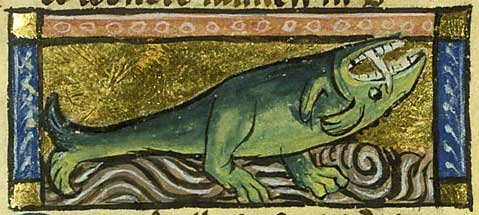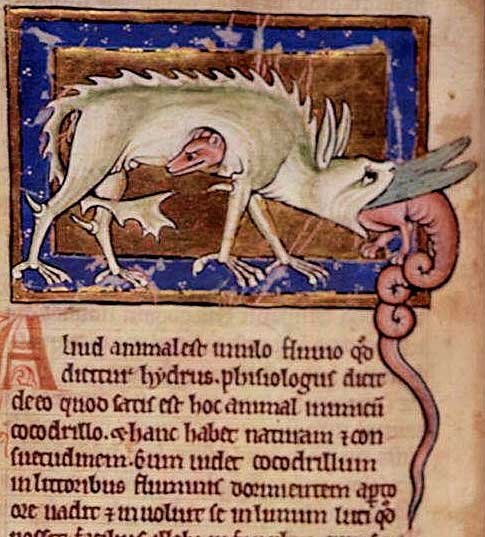Guillaume le Clerc describes the Cocodrille as “a fierce beast that lives always beside the river Nile. In shape it is somewhat like an ox; it is full twenty ells long, and as big around as the trunk of a tree. It has four feet, large claws, and very sharp teeth; by means of these it is well armed. So hard and tough is its skin that it minds not in the least hard blows made by sharp stones. Never was seen another such a beast, for it lives on land and in water” (Guillaume le Clerc, Bestiare).
A Cocodrille is, of course, a crocodile. But its size and thick skin are the least of its wonders. The Cocodrille lives in both land and water (thus inhabiting two regions at the same time). Its upper jaw is movable, while the lower jaw stays in one place when it eats.
Perhaps it is not surprising if most of the wonders of the Cocodrille surround its mouth.
Herodotus notes in the 5th century BCE that since the Cocodrille “lives chiefly in the river, it has the inside of its mouth constantly covered with leeches; hence it happens that, while all the other birds and beasts avoid it, with the trochilus it lives at peace, since it owes much to that bird: for the crocodile, when he leaves the water and comes out upon the land, is in the habit of lying with his mouth wide open, facing the western breeze: at such times the trochilus goes into his mouth and devours the leeches. This benefits the crocodile, who is pleased, and takes care not to hurt the trochilus” (Herodotus, History Book 2). The original game of Crocodile Dentist!
For Pliny the Elder in the 1st century, this odd relationship takes on a dangerous character: “It allows a small bird to enter its mouth to clean its teeth; if it falls asleep with its jaws open while this is happening, the ichneumon jumps down its throat and gnaws its way out through the belly. Dolphins also attack crocodiles, using the sharp fin on their backs to cut open the crocodile’s soft belly” (Pliny the Elder, Natural History, Book 8).
In subsequent accounts, the Cocodrille is almost always being attacked from below, or swallows an animal which eats its way through the Cocodrille’s stomach. Guillaume le Clerc tells how “[the water-serpent, or hydrus], which always lives in the water, hates the crocodile with a mortal hatred. When it sees the crocodile sleeping on the ground with its mouth wide open, it rolls itself in the slime and mud in order to become more slippery. Then it leaps into the throat of the crocodile and is swallowed down into its stomach. Here it bites and tears its way out again, but the crocodile dies on account of its wounds” (Guillaume le Clerc, Bestiare).
Isidore of Seville notes that “The crocodile is named from its golden [crocus] color.” (Etymologies)
For European writers and illuminators in the Middle Ages, Cocodrilles were simply another wondrous creature from a far-off land. How would you draw a crocodile if you had never seen one before? Further confusion was generated by the ambiguity of the creature’s features: it lives in land and in water; does this make it like a newt, a snake, or a fish-cum-lion? Its ferocity is often likened to that of a boar; does it then have similar features? It has four legs, and its habit of allowing birds to enter its mouth could be easily confused with the fox’s trick (the fox plays dead to lure birds close to its corpse…then it snaps them up itself!). Should the Cocodrille look like a fox? Should it appear with the beasts, the snakes, or the water-dwelling creatures in a bestiary? The Cocodrille escapes traditional systems of classification.

A dog-like cocodrille devours a hydrus, who is eating its way out of the cocodrille's stomach. Note the upside-down head: the cocodrille's upper jaw is moveable while its lower jaw is fixed.
The morals which accompany the bestiary Cocodrille assert that the Cocodrille is like a hypocrite, who appears to live virtuously (on land) by day, but returns to foul and muddy waters by night. The upper jaw appears to move in accordance with Holy teaching, but the lower jaw remains unmoved by the Holy Word (T.H. White, Book of Beasts 50-51).
This very moral demonstrates the confusion the Cocodrille generated; since it inhabits both land and water, it must be contradictory or hypocritical.

A fish-like cocodrille in water. Again, the head is upside down to make sense of the "moveable upper jaw" described in the text.
Writers like Bartholomew Anglicus said that if the Cocodrille “findeth a man by the brim of the water, or by the cliff, he slayeth him if he may, and then he weepeth upon him, and swalloweth him at the last” (Bartholowmew Anglicus, De proprietatibus rerum, book 18).

A ferocius fox-like cocodrille of golden (crocus) colour devours a poor little man. Later, the cocodrille will weep.
There is some element of truth to the cocodrille’s weeping: crocodiles do appear to “cry” when their eyes dry out after a prolonged period on land, and alligators appear to weep while eating on land. (University of Florida. “No Faking It, Crocodile Tears Are Real.” ScienceDaily, 3 Oct. 2007. Web. 12 Jan. 2012.)
As for the cocodrille eating a water snake (hydrus) who later chews through its stomach, there is at least one documented case of the reverse occurring when a python ate an alligator.

